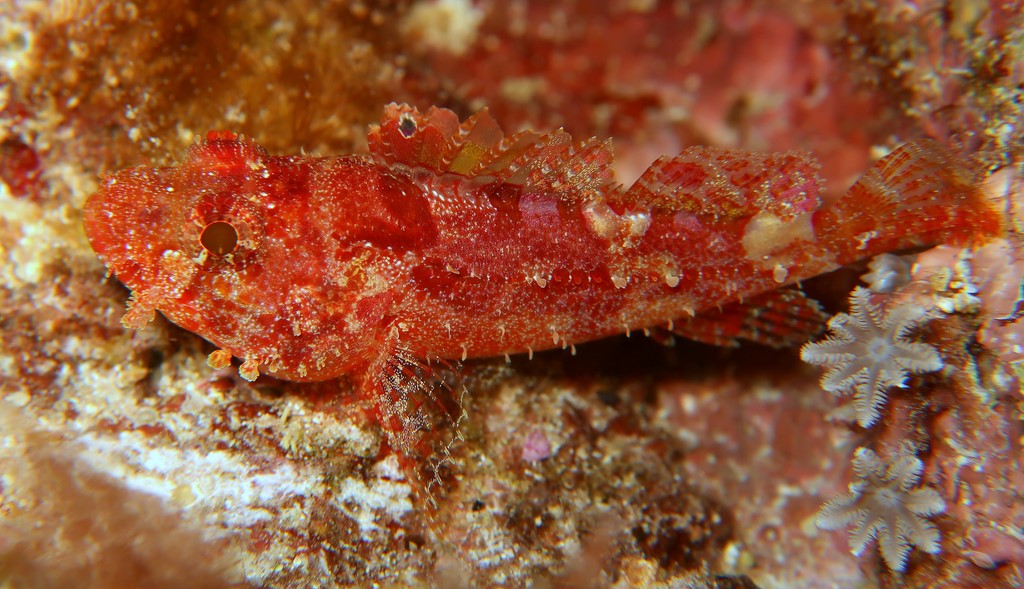IRACUNDUS SIGNIFER - (JORDAN & EVERMANN, 1903)
Picture courtesy of: Alain Daoulas
Actinopterygii (Gigaclass) > Actinopteri (Class) > Teleostei (Subclass) > Perciformes (Order) > Scorpaenoidei (Suborder) > Scorpaenidae (Family) > Scorpaeninae (Subfamily) > Iracundus (Genus)
Poisson-scorpion à piège, Decoy scorpionfish, Lokaas-skerpioenvis, Hatatatekasago, ハタタテカサゴ, 斑点红鲉, 斑點紅鮋,
Synonymes
Iracundus signifer rarotongae (Whitley, 1965)
Iracundus sinifer (Jordan & Evermann, 1903)
Scorpaena asperella (Bennett, 1828)
-------------------------
Description
Dorsal spines (total): 12, in adults, 4th spine notably elongate in specimens over about 50 or 60 mm SL and succeeding spines progressively shorter; Dorsal soft rays (total): 9½-10½; Anal spines: 3; Anal soft rays: 5½; Pectoral fin rays: 17-18 (usually: 18); Lateral scale series: 65-75; Gill rakers: 7/1/12-15 = 20-23. Lateral line scale: 25-26. Lachrymal with 2 spines over maxillary (first spine points forward; Second spine broad, pointing posterolaterally); Suborbital ridge without spines except for 1 spine at rear before preopercle; Preopercular spines short, usually only 3 developed, with no supplemental preopercular spine at base of the uppermost spine. No palatine teeth. Vertebrae: 9 + 15 = 24. Scale ctenoid. Max. length: 13.0 cm TL. Depth range: 20 - 217 m.
Color
Body white with red mottling in ~4 oblique, irregular, interrupted saddles; Small black spot between dorsal fin spines 2-3.
Etymology
Iracundus: from Latin, īrācundus = passionate, wrathful (red with anger). Referring to vermilion body color in life.
signifer: from Latin, signum = visible indication: sign, mark, signal + from Latin, ferō = I bear, carry. Referring to single jet-black spot about half diameter of pupil near tip of membrane between second and third spines of dorsal fin.
Orignal description: Iracundus signifer Jordan & Evermann, 1903 - Type locality: Honolulu, Oahu Island, Hawaiian Islands.
Distribution
Indo-West Pacific: South Africa, Comoros and Madagascar to western Mascarenes (La Réunion, Mauritius); Taiwan north to Izu Islands (Japan); New Caledonia, Hawaiian Islands; Cook Islands to Pitcairn Group, south to Rapa (probably more widespread).
Biology
Found on sand and rubble under ledges of seaward reefs. Benthic. The dorsal fin mimics a tiny fish and is used as a lure. Anterolateral glandular groove with venom gland.
Last update: 7, September 2024
Actinopterygii (Gigaclass) > Actinopteri (Class) > Teleostei (Subclass) > Perciformes (Order) > Scorpaenoidei (Suborder) > Scorpaenidae (Family) > Scorpaeninae (Subfamily) > Iracundus (Genus)
Poisson-scorpion à piège, Decoy scorpionfish, Lokaas-skerpioenvis, Hatatatekasago, ハタタテカサゴ, 斑点红鲉, 斑點紅鮋,
Synonymes
Iracundus signifer rarotongae (Whitley, 1965)
Iracundus sinifer (Jordan & Evermann, 1903)
Scorpaena asperella (Bennett, 1828)
-------------------------
Description
Dorsal spines (total): 12, in adults, 4th spine notably elongate in specimens over about 50 or 60 mm SL and succeeding spines progressively shorter; Dorsal soft rays (total): 9½-10½; Anal spines: 3; Anal soft rays: 5½; Pectoral fin rays: 17-18 (usually: 18); Lateral scale series: 65-75; Gill rakers: 7/1/12-15 = 20-23. Lateral line scale: 25-26. Lachrymal with 2 spines over maxillary (first spine points forward; Second spine broad, pointing posterolaterally); Suborbital ridge without spines except for 1 spine at rear before preopercle; Preopercular spines short, usually only 3 developed, with no supplemental preopercular spine at base of the uppermost spine. No palatine teeth. Vertebrae: 9 + 15 = 24. Scale ctenoid. Max. length: 13.0 cm TL. Depth range: 20 - 217 m.
Color
Body white with red mottling in ~4 oblique, irregular, interrupted saddles; Small black spot between dorsal fin spines 2-3.
Etymology
Iracundus: from Latin, īrācundus = passionate, wrathful (red with anger). Referring to vermilion body color in life.
signifer: from Latin, signum = visible indication: sign, mark, signal + from Latin, ferō = I bear, carry. Referring to single jet-black spot about half diameter of pupil near tip of membrane between second and third spines of dorsal fin.
Orignal description: Iracundus signifer Jordan & Evermann, 1903 - Type locality: Honolulu, Oahu Island, Hawaiian Islands.
Distribution
Indo-West Pacific: South Africa, Comoros and Madagascar to western Mascarenes (La Réunion, Mauritius); Taiwan north to Izu Islands (Japan); New Caledonia, Hawaiian Islands; Cook Islands to Pitcairn Group, south to Rapa (probably more widespread).
Biology
Found on sand and rubble under ledges of seaward reefs. Benthic. The dorsal fin mimics a tiny fish and is used as a lure. Anterolateral glandular groove with venom gland.
Last update: 7, September 2024
